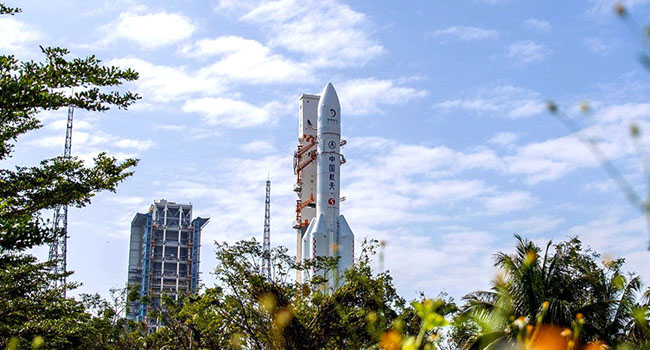Chinese Probe Lands On Moon To Gather Lunar Samples

![]()
A Chinese space probe on Wednesday began drilling on the surface of the Moon hours after landing, in an ambitious attempt to bring back the first lunar samples in four decades.
Beijing has poured billions into its military-run space programme, with hopes of having a crewed space station by 2022 and of eventually sending humans to the Moon.
The Chang’e-5 spacecraft — named for the mythical Chinese moon goddess — touched down on the near side of the Moon on Tuesday, and is now gathering samples from the surface, the China National Space Administration said.
Chang’e-5’s goal is to collect lunar rocks and soil to help scientists learn about the Moon’s origins, formation and volcanic activity.
If the return journey is successful, China will be only the third country to have retrieved samples from the Moon, following the United States and the Soviet Union in the 1960s and 1970s.
This is the first such attempt since the Soviet Union’s Luna 24 mission in 1976.
Chinese foreign ministry spokeswoman Hua Chunying on Wednesday described the mission as “revolutionary in increasing human understanding of the history of the Moon.”
The probe had finished drilling for samples by Wednesday morning and is now “gathering surface samples as planned”, China’s National Space Administration said.
The spacecraft was launched from the country’s southern Hainan province last week and entered lunar orbit on Saturday after a 112-hour journey.
State broadcaster CCTV showed rows of scientists at mission control, wearing blue jackets emblazoned with Chinese flags, monitoring the probe then clapping after it successfully touched down.
A huge screen at the front of the room displayed images sent by the probe of the grey lunar surface.
A separate state media video released later showed the probe drilling into the moon’s surface.
– ‘No easy task’ –
The spacecraft plans to collect two kilograms (4.5 pounds) of material in a previously unexplored area known as Oceanus Procellarum — or “Ocean of Storms” — a vast lava plain, according to the science journal Nature.
The probe was designed to both get samples from the Moon’s surface, as well as drill a two-meter (7-foot) deep hole and gather specimens from there, to ensure a diverse collection.
State media said the craft was preparing for “around 48 hours” of tasks on the lunar surface.
The samples will then be returned to Earth in a capsule programmed to land in northern China’s Inner Mongolia region in December, according to US space agency NASA.
Back on Earth, Chinese scientists are using footage from Chang’e-5 to reconstruct patches of the Moon’s surface in a lab to better guide the probe’s movements, CCTV said.
Footage from the broadcaster showed lab staff from the China Academy of Space Technology wearing augmented reality glasses and using shovels to shape a sandpit according to contours of the moon’s surface.
The mission is technically challenging and involves several innovations not seen during previous attempts at collecting moon rocks, Harvard-Smithsonian Center for Astrophysics researcher Jonathan McDowell told AFP last month.
Thomas Zurbuchen, a top official at NASA’s science mission directorate, congratulated China on the landing.
“This is no easy task,” he tweeted. “When the samples collected on the Moon are returned to Earth, we hope everyone will benefit from being able to study this precious cargo that could advance the international science community.”
– ‘Space dream’ –
Under President Xi Jinping, plans for China’s “space dream”, as he calls it, have been put into overdrive.
Beijing is looking to finally catch up with the US and Russia after years of belatedly matching their space milestones.
China launched its first satellite in 1970, while human spaceflight took decades longer — with Yang Liwei becoming China’s first “taikonaut” in 2003.
A Chinese lunar rover landed on the far side of the Moon in January 2019 in a global first that boosted Beijing’s aspirations to become a space superpower.
The latest probe is among a slew of ambitious targets, which include creating a powerful rocket capable of delivering payloads heavier than those NASA and private rocket firm SpaceX can handle, a lunar base, and a permanently crewed space station.
China’s taikonauts and scientists have also talked up crewed missions to Mars.
–AFP





